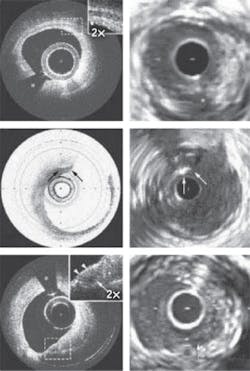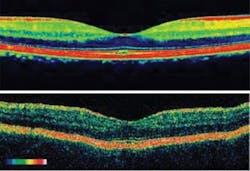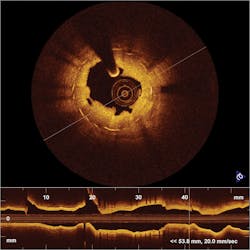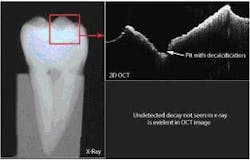MARKET & TECHNOLOGY STATUS UPDATE: Technology, applications and future directions: OCT in 2011 and beyond
EDITOR'S NOTE: This article is an excerpt of the report, "Optical Coherence Tomography 2010: Technology, Applications, and Markets," by Strategies Unlimited, updated to reflect developments new since its publication. For more information or to receive the complete report, visit http://store.strategies-u.com/products/optical-coherence-tomography-2010-technology-applications-and-market.html.
This is an exciting time for optical coherence tomography (OCT). The technology's global market grew from less than $10 million in 2001 to more than $275 million in 2009—and it's expected to reach nearly $800 million by 2014. The noncontact, fast and relatively high-resolution imaging technology was invented in 1991 and commercialized for medical applications in 1996. Due to its ability to produce noninvasive, cross-sectional images of the retina that previously required invasive biopsy and histology procedures; within 15 years, OCT became a standard of care technology in ophthalmology. Now, having received approval from the U.S. Food and Drug Administration (FDA) for two new clinical applications in 2010, the technology is beginning to get a foothold in other areas that may surpass ophthalmology.
OCT's value proposition
Even though OCT cannot image as deeply as ultrasound, CT or MRI (its penetration depth in tissue is just 2−3 mm), it has advantages over these techniques. The operation of OCT is similar to that of ultrasound imaging (it uses low-coherence light the way ultrasound uses sound waves), but it produces images of superior resolution (see Fig. 1). And it does so without contact—which is a key advantage for applications such as ophthalmology.
In the medical imaging world, OCT, with resolution of 5−10 μm, sits between ultrasound and microscopy. Ultrasound, with a resolution of around 150 μm, is best used to visualize organs, while confocal microscopy, with resolution of 1 μm, is best for imaging at the cellular level, though it has the disadvantage that the tissue must be excised first. OCT fits in nicely where high-resolution, noninvasive imaging of tissue morphology is required.
The impact of technology advances
In terms of technology, the most significant development since the invention of the technology has been the advent of Fourier domain OCT (FD-OCT), which offers two to three times better sensitivity and 50 to 100 times the speed of time domain OCT, the original incarnation of the technology. The speed advance translates to such advantages as reduced motion artifacting, higher practical resolution, and the ability to precisely register OCT imagery for tracking disease progression.
The nomenclature of this new generation of devices has not yet been standardized: "Fourier domain" describes the broad category, though it is sometimes also called "spectral domain." In any case, there are two different types of Fourier domain systems—typically called "spectral domain OCT" for the case where the full spectrum is detected simultaneously, and "swept source OCT" where the scanning laser is used.
A complicating factor is that FD-OCT is more difficult at the 1310-nm wavelength typically used outside of ophthalmology. High-speed, inexpensive CCD cameras cannot be used at this wavelength, so system designers must either use expensive ($15,000) InGaAs arrays or move to swept source systems, where the cost and complexity of the optical source goes up. As an example, cardiovascular applications began moving to FD-OCT in 2007 and 2008, opting for swept source systems.
Applications
Ophthalmology was the first commercial application of OCT, and it's expected to remain the dominant commercial application through 2014. Through 2005, one company, Carl Zeiss Meditec, controlled over 95% of the market in ophthalmology with its time domain technology. The first FDA approval for FD-OCT occurred in late 2006 and that technique is not, in all cases, protected under the original tightly held patents that limited competition. So today, at least 10 companies market advanced FD-OCT ophthalmic imaging systems (see Fig. 2).While there are important hardware differences among some of the machines (Heidelberg's eye tracking feature and OPTOPOL 3-nm resolution are key examples); increasingly, software will become the key differentiator among competitors: data management tools, comparative databases, and application-specific software will be critical to help practitioners make full use of the imagery they capture.
However, a number of other medical applications, including cardiology, dermatology, dentistry and oncology, are poised to be released in the coming years, each with potential markets equal to or larger than that of ophthalmology. In fact, more than 20 companies are developing and/or marketing OCT systems in eight medical specialties, as well as general research.
Almost from the start, the potential for using OCT in the evaluation of atherosclerosis, or thickening and hardening of the walls of medium and large arteries, was seen as a powerful application. Today, OCT is being marketed for vulnerable plaque assessment and stent visualization: In May 2010, LightLab Imaging, since acquired by global medical device company St. Jude Medical, Inc. (St. Paul, MN), announced receipt of the FDA's first clearance for a clinical OCT system to be applied to cardiovascular imaging (see Fig. 3). Competitor Volcano Corp. expects commercial release of its second-generation OCT catheter and system in Europe early this year and in the U.S. in mid-2011. Volcano plans to combine OCT and IVUS on the same catheter, and in fact has a roadmap to accomplish this.Other applications
Noninvasive blood glucose monitoring has long been a "holy grail" application pursued by many different companies and technologies. Indeed, by one estimate, over 100 companies have tried and failed to produce a noninvasive blood glucose instrument. Over the years, several companies have investigated using OCT to solve this problem, though.
While the use of OCT in oncology is in its early stages; in a relatively short time, a significantly diverse number of cancers have been imaged, including breast, bladder, brain, gastrointestinal, respiratory, reproductive tract, skin, and ear, nose and throat. Most OCT applications within oncology fall into two broad classes: Early detection (that is, imaging of small lesions that may not be visible on gross examination) and surgical margin evaluation (imaging of tissue excised during surgery to ensure that the entire cancer was removed).
Opportunities exist for medical device companies to apply OCT in these and other specialties, and a number of OCT companies have been acquired in the past couple of years. Opportunities also exist for technology providers who manufacture superluminescent diodes and tunable lasers, fast scanning cameras and fiber optic components, as well as those who provide optical subsystem and/or optical probe design.
One way commercial entities will likely continue to differentiate products will be integration of OCT with other imaging modalities. Indeed, Volcano Corp. aims to challenge LightLab in the cardiovascular market by integrating OCT and ultrasound, an area in which it is a leader.
Also, because the light source used in the OCT system can detect other features and characteristics in different operating modes, the potential exists to concurrently extract tissue composition information via polarization-sensitive imaging or spectroscopic detection. Other areas that show particular promise include ultra-high-resolution OCT (UHR OCT), polarization-sensitive OCT (PS OCT), adaptive optics OCT and Doppler OCT.
This is a dynamic time for OCT, and many changes, advancements and improvements are expected, as researchers and companies continue to refine and optimize the technology and products.




